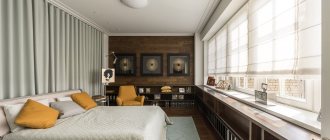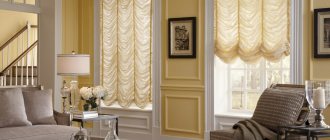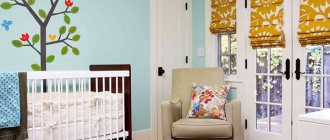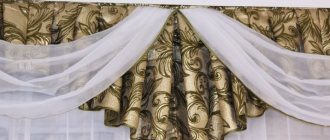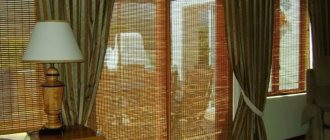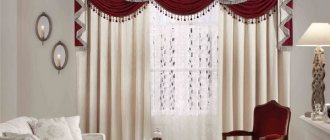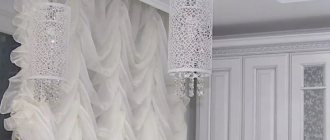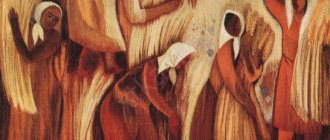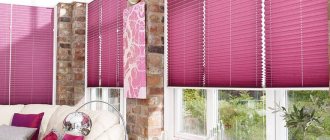Advantages and disadvantages
Here are the main advantages and disadvantages of the veil.
pros | Description |
| Softness and ease of drape | The fabric is pleasant to the touch and easily creates the desired window design. Folds and flowing drapery are quite feasible. |
| Moderate transparency | The fabric does not make it possible to recognize the clear outlines of the silhouette. |
| Dim and block sunlight | Voile curtains can be placed on windows that are oriented to the south, southeast sides of the world. |
Minuses | |
| Low strength | Due to its softness, the veil is prone to damage and therefore requires care. Spinning is contraindicated for the material, and it is advisable to wash it on a delicate cycle. |
| Difficult to remove contaminants | Stains are difficult to remove, so it is advisable not to make voile curtains in the kitchen, dining room or nursery. The spots are also clearly visible in daylight. |
| Ability to electrify | The fabric attracts dust and gets dirty very quickly. |
Flaws
- quickly become contaminated.
- Over time it loses its color.
- poorly ironed;
- When washed at high temperatures, the veil may lose its aesthetics.
Important: the veil does not need to be wrung out. When washing by hand, such curtains should not be twisted.
When purchasing voile fabric for curtains, you need to consider the following nuances. If you hang white curtains made of natural fibers in the kitchen, the settling splashes of grease will collect dust. It will be difficult to remove the absorbed dirt and this work will have to be done frequently.
It is better to take a synthetic veil of darker colors. There are numerous of them. You can choose different colors of voile curtains. The main thing is to take all factors into account.
Types of curtains
Curtains with a veil fit perfectly into the interior and become indispensable in creating a cozy space. Inexhaustible design experiments set the variability of draperies in the interior.
Curtains
There are many types of curtains, but their shape is characterized by simplicity and conciseness. A common design of curtains in the interior is scissor curtains, which have a classic rectangular shape of curtains that go down to the floor with the same length on both sides. Scissor curtains are often combined with eyelets, which makes the interior more modern.
Double
Give the space volume and luxury. The first layer (closer to the window) can serve as a curtain from sunlight, and the second can set the mood and design.
Roman
Roman blinds using a veil create a stylish space. With the help of multi-level fixation of the canvas in height, the window opening always has a new image.
The photo shows a kitchen with Roman blinds.
Photo curtains
If the interior lacks a compositional center, then photo curtains will come to the rescue. The modern manufacturer offers a wide range of thematic subjects - from a finely floating butterfly frozen on the surface of tulle, to a large drawing (architecture, nature, technology, etc.).
Austrian
Austrian curtains are self-sufficient in any space and rarely need to be combined with other types of curtains. If desired, they are decorated with fringe, lace, cords and other decor. Models decorated with contrasting fabric roses or bows look very elegant and romantic.
The photo shows Austrian curtains with a pattern.
French
This type of curtains is beautiful and formal. French voile curtains are often found in offices, living rooms, and kitchens. Pastel colors are predominantly used, and the most popular of them is ivory. .
The photo shows French curtains with a decorative beaded edging along the edge.
Similarities and differences between veil and organza
Fabrics for decorating window and door openings have similar qualities, not only in their purpose and color schemes.
Tulle curtains
Tulle veil:
- denser than organza;
- soft texture;
- matte canvas;
- good light transmission;
- easily forms compositions in curtain drapery;
- Smooth fabric to the touch.
On a note! Disadvantages include poorly removed stains and fading under the influence of sunlight, low strength and high creasing of the canvas.
The appearance of hooks that can ruin not only the appearance, but the integrity of the curtain.
White tulle veil
Organza does not allow air to pass through well. More expensive, but less elegant compared to the veil. High strength allows use in the kitchen and hallway. Washes well. The texture is more rigid, and the surface has a shine. Not suitable for use on the sunny side, or requires additional thick curtains
On a note! There is no clear answer to the question of veil or organza, which is better. It all depends on where the curtain from a particular fabric will be used.
Veil
Translucent fabric, designed to decorate the interior of a room and hide imperfections in repairs or personal life from prying eyes, is called a veil. Curtains made from this fabric can visually change the size of the space within the room. Horizontal stripes will expand a narrow room, while vertical stripes will make low ceilings appear higher. Excellent protection from the sun and creating a romantic design with the power of a white veil.
One of the disadvantages of the veil is the susceptibility of the canvas to electrification, which attracts dust particles and contaminates the curtains. Stains are difficult to remove, so curtains made from this fabric are not recommended for use in the kitchen. Perfect for darkening a room on the sunny side. Tulle veil or organza, which is better, no one can answer, because the use of both is possible even within the same lambrequin-type design.
You may be interested in this Step-by-step guide to sewing tulle yourself
Colored organza
Organza
Tulle fabric, characterized by strength and rigidity, is a type of organza. The advantages of the material are:
- tensile strength;
- light transmittance;
- durability in operation;
- does not fade in the sun;
- ability to keep shape due to rigidity;
- Resistant to cleaning solvents.
Its use in decorative elements in the form of bows and curtain tiebacks echoes its use in decorating wedding halls, decorating motorcade cars and arranging flower arrangements.
Blue organza
Disadvantages include capriciousness in cut and the need for special care. The bright shimmer of glossy fabric can easily be ruined by a hot iron when ironing, creating a hole.
Modern technologies use fabric for printing designs, machine embroidery and gold plating. One of the latest varieties of organza is “chameleon” fabric, cast in different shades when exposed to light.
What distinguishes tulle from organza is its softness and ability to form beautiful folds when decorating a lambrequin.
Microveil
Microveil and veil: the difference
The fabric appeared on the market relatively recently, and is considered a new product among tulle materials. It is considered a micro-veil, which is characterized by softness, and a semi-organza, which has elasticity and the ability to transmit sunlight.
A new type of material does not lose shape after washing, does not fade in the sun and does not shrink. Combining the positive qualities of a veil and organza in one fabric. Therefore, the question of which is better, semi-organza or veil, is not entirely relevant.
Weighted with fringed ribbon
The new generation fabric is stronger than veil and thin as organza. The microveil drapes into beautiful folds, improving the visual perception of the space of the room.
In the production of new items, various fibers are used - silk, linen, cotton and wool, synthetics. The color design is multifaceted - from color solutions to the application of drawings, patterns, and ornaments. Microveil and veil - the difference lies in the purpose more than in the care.
Unlike veils, the new product can be used for draping beds, niches, false windows, and doorways. Fabric care requires delicate washing and ironing in the most gentle mode. There are plenty of fabrics to choose from on the market for decorating window and door openings.
For the living room
Curtain sizes
The height of the curtains can create an ambiguous visual effect in the room - from a space with high ceilings to the illusion of a doll's house.
Short
This type is appropriate in the kitchen area. It is worth noting that such curtains will harmoniously fit into a room with high ceilings.
Long
Curtains reaching the floor, and sometimes deliberately flowing across its surface, visually make the room taller. When using a vertical stripe, this effect is enhanced.
The photo shows a living room with long voile curtains on an elegant matte cornice.
Ideas in the interior of rooms
Voile drapery looks great in all living spaces.
Kitchen
White curtains look impressive in the kitchen area, but the presence of a print in the curtain enlivens the space and makes everyday dirt less noticeable. Acceptable designs are flowers, monograms, peas, stripes, etc.
Bedroom
In the bedroom, curtains with natural patterns, monograms, and stripes will create a relaxing atmosphere. A calming effect can be achieved by choosing the right colors: peach, beige, brown, green, etc.
The photo shows a bedroom in beige colors.
Living room or hall
A curtain with a pleated effect will fit perfectly into the living room interior, making the space airy and light. Also, the veil serves as an excellent addition to drapery with other types of curtains in the bedroom.
Children's room
A comfortable environment in a children's room also depends on the choice of textiles. Pastel shades of curtains will calm a hyperactive child, and bright colors will make the space dynamic.
Balcony
If the windows of the house face the sunny side, then you should pay attention to curtains with a veil of muted tones with high density, and if the interior space does not have enough insolation, light shades are suitable.
The photo shows a balcony with light beige curtains.
Bathroom
The bathroom is perhaps the only area where any type of voile curtains can be used.
The photo shows a bathroom with airy voile curtains in combination with linen Roman blinds.
Types of two-color voile curtains and their combinations
Classic voile curtains of two colors are a standard way to decorate a window. But with the right approach and choice of color, there is a chance to create something unique and captivate the hearts of your household and guests. Such tulle can consist of two or more canvases, complemented by lush or simple lambrequins, with or without tiebacks, it will also depend on the overall style of the room.
Classic two-color curtains can be decorated with a light lambrequin made of a different fabric
At first glance, the crossed curtains of the veil resemble classic tulle, but their main difference is this: the crossed curtains in the upper part, on the eaves, completely lie on top of each other, and towards the bottom they diverge in different directions. Such curtains usually consist of two canvases of different colors, and then it’s up to your imagination.
In the photo, crossed curtains are sewn together at the top and secured to the cornice with eyelets
Austrian curtains can also be made from voile fabric. It is better to use two colors for this model when there are several windows in the room and all of them are decorated with Austrians.
In the photo the tulle is not only of two colors, but also of two different models - Austrian and Italian
Short voile curtains are good for small rooms or kitchens. Combinations of two colors, and if also different fabrics - plain or with a pattern, will give the window opening a cheerful, festive look. The bottom edge of short tulle can be straight, oblique or arched.
Double tulle made of a plain veil and a veil with a pattern diversifies a boring interior
Color spectrum
Modern curtain manufacturers provide many color palettes, the colors of which will suit almost any interior.
- White. A classic color that is appropriate in any interior. If the boiling white needs to be muted, a milky curtain will come to the rescue.
- Green. Calming shades of green will perfectly balance the space. And shades of light green will make the space fresh and unusual.
- Grey. Trendy gray voile curtains combined with white surfaces and furnishings will make the space modern.
- Beige. Beige curtains will bring nobility and sophistication to the interior. And although this color is one of the traditional ones, it is popular at any time for people who want to create a warm environment.
- Lilac. Lilac curtains refresh any space.
- Turquoise. Turquoise curtains combine two colors - blue and green, which in turn give the space coolness and sea freshness.
- Black. Curtains in dark shades add depth to the room and block sunlight well.
- Blue. Blue curtains can be ideally combined with turquoise, purple, white, and blue colors. An interesting combination will turn out with green and gray companions.
- Red. Red curtains accentuate the image of the window.
Color combinations
The overall appearance of the room and its transformation will depend on how correctly you manage to choose shades for curtains of two colors. Certain rules must be followed to achieve a good result.
Contrasting combinations are always in fashion: white with black, red, blue. Such two-color combinations bring brightness to the interior and give the owners a cheerful mood.
Tulle with eyelets is not only stylish and modern, but also very comfortable, the fabric easily slides along the cornice and can be changed in any way
Neutral beige and cream shades of the veil can be complemented with a brown tone for a cozy look that will warm up your living room or bedroom on a cold winter evening.
It is better to gather the curtains next to the refrigerator into tiebacks on one side
For lovers of a marine theme with marine shades, you can use a sea green veil in combination with sand or noble gray.
Blue and white refreshes the interior and gives a calm atmosphere
For calm, understated combinations of two-tone tulle, use tones from the same palette, such as sky blue and royal blue, or lilac and lilac. Such neutral combinations look beautiful in a monochrome interior without elaborate decorations or prints.
Remember that in a small room it is better not to use a lot of bright colors, it eats up space.
With different degrees of room illumination, the choice of colors for two-color tulle may differ: sunny windows will refresh curtains in cold colors, for example, a combination of white with blue or green, and for northern dark windows, bright shades of the sun will serve as a warming decor: yellow, orange, lemon and salad.
With wide bay windows, two-color compositions are more relevant than anywhere else
A sunny shade can give your living room warmth and homeliness
Design and drawings
Voile curtains have a variety of designs from royal patterns, natural and geometric patterns, to subtle small prints. Each of them finds its place in interiors.
With embroidery
Embroidered designs bring sophistication and romance to the interior. Such airy curtains will perfectly complement the look of a living room, bedroom or nursery.
The photo shows openwork voile curtains in the kitchen area. Beautiful white cups, lampshade and kitchen fronts create an airy image.
Rainbow
Curtains with a rainbow motif will make the space positive and will also be a good addition to a child's room.
Patterns and ornaments
Light patterns on the curtain will emphasize the elegance of the window opening and the space as a whole.
Flowers
Floral motifs enliven any space and make it sophisticated.
Embossed
If you want to include a pattern in the space, then you can opt for embossed curtains. The most common motifs are monogram, butterfly, branches with leaves, geometry, etc.
Multicolor
Curtains with a gradient color transition from light to dark shades look unusual and sophisticated. Also in the textile industry, there is an ombre effect, different colors of which smoothly flow from one to another.
Multilayer
Curtains made from several rows of veil create a feeling of luxury in the interior.
Decoration elements
Let's look at the most common elements of curtain decoration.
- Pickups. This element will be revived and will add a soft elliptical line to a straight curtain. The design of tiebacks is varied - metal, fabric, tassels, floral arrangements, etc. The visual effect of the entire space as a whole depends on the height of the hook with tiebacks. So, you can visually expand the space in width, or increase the room in height.
- Lambrequins. The finished image of curtains is set by lambrequins, but their participation usually comes down to decorating the window in a classic style.
- With beads. The presence of beads in the curtains transforms the image of the window, setting a note of playfulness and romance. A wonderful addition to the beads will be small inclusions of small tassels and rhinestones.
Combination options
The veil goes well with other types of fabrics, such as linen, cotton, velor, mesh, etc.
Drapes and curtains
The composition of drapes and curtains in two colors will give the space airiness and lightness.
Thread curtains (muslin)
Unusual curtains made of threads will be an original solution in the interior. They are self-sufficient, but can be perfectly combined with other types of curtains. They solve well the zoning of space by forming airy thread walls.
Functions of curtain weights
The use of fittings to improve the appearance of curtains is also dictated by the lightness of the fabrics. A veil with a weighting agent, what is it, the average person who is not faced with the purchase of fabrics for decoration will ask.
You might be interested in the materials from which tulle is made: what fabrics are used
Types of weighting agents are distinguished according to their functional purpose:
- slats;
- weights;
- cords;
- tapes.
On a note! Different types of additional weight for tulle are used depending on the type of fabric and the desired result.
There is a big difference between a weighted and an unweighted veil. A sewn cord into the curtain edging significantly improves the aesthetic perception of the tulle.
Doesn't need weighting
How to care and clean?
A suitable option for cleaning the veil is hand washing, but if you don’t have enough time, you can refresh the curtains in the washing machine by following these recommendations:
- Choose a delicate mode and a temperature of no more than 40 degrees. It is not recommended to set the temperature higher, as the fabric shrinks during washing;
- How to bleach and what to bleach with? Oxygen or optical brighteners will help prevent fabric from being damaged. The latter are not suitable for colored veils. The products should not contain chlorine;
- The product is ironed slightly damp at a temperature of 100 °C and hung on a cornice.
Photos of thread curtains
Read here How to decorate curtains - useful tips and options for the best decoration ideas on 115 new photos!
Did you like the article? Share 
